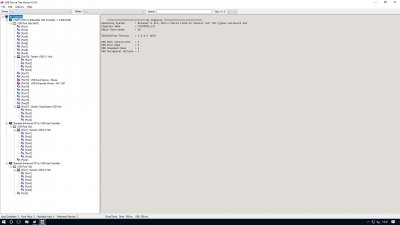- Joined
- Aug 19, 2010
- Messages
- 46
- Motherboard
- I still didn't
- CPU
- read the
- Graphics
- Rules!
- Mac
- Classic Mac
- Mobile Phone
USB seems to be the biggest problem with El Capitan and I imagine subsequent OS X versions. In the past few weeks I have read a lot from various people, many of whom have done some great work.
One of the posts that I thought provided a logical approach was that by Xavi16 where he took time to map the ports on the Asus Rampage V Extreme. This inspired me to do the same with my Asus X99a/USB3.1. I also felt that I should give a little back to these great web sites that help us all.
To do this, I used a free program called USB Tree Viewer (not to be confused with USBView). This gives a lot more information that seems relevant to OS X. The only downside is that you have to do a Windows installation.
I am under the impression that USB Tree Viewer has not been updated for a long time as it really didn't like the USB 3.1 ports on my board! I'm not too worried about them, really as I will be using the on-board M.2 interface and these ports are disabled when using a 28-lane possessor, which I am (5820k).
I have learnt a lot from doing this and also from the extensive amount of work done by others. Here are some points which I hope will be helpful to others:
1. There is a difference between 'physical' posts actually on the motherboard and 'logical' ports as used by the operating system.
2. I believe that one the reason USB looks messed up in the Apple System Profiler is because OS X doesn't negotiate the built-in hubs properly. We are used to seeing everything connected under USB 3.0, for example which obviously incorrect.
Using RehabMan's FakePCIID.kext and FakePCIID_XHCIMux.kext you can go some way to getting things sorted out. Ideally however, I think that the kexts need to be edited for your specific motherboard.
I'm not sure where to go from here. Having the information is one thing but knowing what to do with it is another. I think I am going to have either edit my DSDT or some of RehabMan's kexts or both.
Once I get my X99A/USB3.1 running smoothly, I intend to perform the same remapping exercise on my old Gigabyte GA-X79-UD3.
It would fantastic if others could do the same with their motherboards. I have made my USB mappings available here for anyone else who has an Asus X99a/USB3.1 or who may find it useful.
EDIT: The screen grab of USB Tree Viewer was taken AFTER I disabled USB3.1 in BIOS as I am now switching to OS X.
One of the posts that I thought provided a logical approach was that by Xavi16 where he took time to map the ports on the Asus Rampage V Extreme. This inspired me to do the same with my Asus X99a/USB3.1. I also felt that I should give a little back to these great web sites that help us all.
To do this, I used a free program called USB Tree Viewer (not to be confused with USBView). This gives a lot more information that seems relevant to OS X. The only downside is that you have to do a Windows installation.
I am under the impression that USB Tree Viewer has not been updated for a long time as it really didn't like the USB 3.1 ports on my board! I'm not too worried about them, really as I will be using the on-board M.2 interface and these ports are disabled when using a 28-lane possessor, which I am (5820k).
I have learnt a lot from doing this and also from the extensive amount of work done by others. Here are some points which I hope will be helpful to others:
1. There is a difference between 'physical' posts actually on the motherboard and 'logical' ports as used by the operating system.
2. I believe that one the reason USB looks messed up in the Apple System Profiler is because OS X doesn't negotiate the built-in hubs properly. We are used to seeing everything connected under USB 3.0, for example which obviously incorrect.
Using RehabMan's FakePCIID.kext and FakePCIID_XHCIMux.kext you can go some way to getting things sorted out. Ideally however, I think that the kexts need to be edited for your specific motherboard.
I'm not sure where to go from here. Having the information is one thing but knowing what to do with it is another. I think I am going to have either edit my DSDT or some of RehabMan's kexts or both.
Once I get my X99A/USB3.1 running smoothly, I intend to perform the same remapping exercise on my old Gigabyte GA-X79-UD3.
It would fantastic if others could do the same with their motherboards. I have made my USB mappings available here for anyone else who has an Asus X99a/USB3.1 or who may find it useful.
EDIT: The screen grab of USB Tree Viewer was taken AFTER I disabled USB3.1 in BIOS as I am now switching to OS X.
Attachments
Last edited:

